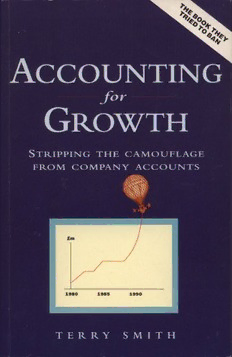
Accounting for Growth: Stripping the Camouflage from Company Accounts PDF
Preview Accounting for Growth: Stripping the Camouflage from Company Accounts
ACCOUNTING FOR GROWTH For Katy andEmily ACCOUNTING FOR GROWTH Stripping the Camouflage from Company Accounts Terry Smith c CENTURY BUSINESS Copyright © Terry Smith1992 The right ofTerry Smith to be identified asthe author ofthis work has been asserted by him in accordance with the Copyright, Designs and Patents Act 1988 First published in 1992in Great Britain by Century Business An imprint ofRandom House UK Limited 20 Vauxhall Bridge Road, London SWIV 2SA Random House Australia (Pry) Limited 20 Alfred Street, Milsons Point, Sydney New South Wales2061,Australia Random House New Zealand Limited 18Poland Road, Glenfield Auckland10, New Zealand Random House South Africa (Pty) Limited PO Box337, Bergvlei, South Africa Typeset in Bembo by SX Composing Ltd, Rayleigh, Essex Printed and bound in Great Britain"by Mackays ofChatham PLC, Chatham, Kent BritishLibrary Cataloguing in Publication Data A catalogue record for this book is available from the British Library ISBN~7126-5764--9 Companies, institutions and other organizations wishing to make bulk purchases ofthis title or any other Century Business publication should contact: Direct SalesManager Century Business Random House 20Vauxhall Bridge Road London SWIV 2SA Fax:071-8286681 Contents Acknowledgements VI PART I 1 INTRODUCTION 3 2 How COULD IT HAPPEN? 7 PART 11 ACCOUNTING TECHNIQUES: ACQUISITION AND DISPOSAL 3 THE 1980s - DECADE OF THE DEAL 15 4 THE PRE-ACQUISITION WRITE-DOWN 22 5 DISPOSALS 37 6 DEFERRED CONSIDERATION 52 PART III OTHER ACCOUNTING TECHNIQUES 7 EXTRAORDINARY AND EXCEPTIONAL ITEMS 63 8 OFF BALANCE SHEET FINANCE 76 9 CONTINGENT LIABILITIES 92 10 CAPITALISATION OF COSTS 101 11 BRAND ACCOUNTING 116 12 CHANGES IN DEPRECIATION POLICY 126 13 CONVERTIBLES WITH PUT OPTIONS AND AMPS 137 14 PENSION FUND ACCOUNTING 148 15 CURRENCY MISMATCHING 169 PART IV 16 MAJOR COMPANIES ACCOUNTING HEALTH CHECK 183 17 SURVIVAL TECHNIQUES IN THE ACCOUNTING JUNGLE 193 APPENDIX I COLOROLL 206 APPENDIX 11 BRITISH & COMMONWEALTH 211 APPENDIX III POLLY PECK 221 Index 224 Acknowledgements Without engagingin wordy platitudes, it isnecessary for me to express my indebtedness to my colleagues in the UK Company Research Department ofUBSPhillips & Drewfor their help incompiling theinformationfor this book. Apart from widespread help in compiling the examples and completing the Major Companies Accounting Health Check, special mentionshouldgo to RichardHannah, the ShippingandTransportanalyst, who co-authored the original Accounting for Growth research report. The otherindividual who must be singled out for mentionismy assistant Sally Dell who prepared the manuscript, and patiently accepted my corrections, changes and handwriting. Ifully acknowledgethat thecommentsexpressed in this book are my opinions, and I am not suggesting that the practices analysed are illegal, or that they even contravene Generally Accepted Accounting Practice (alsoknown as'GAAP') or that the various companies and accountants mentioned did not have valid reasons for using these techniques. I am more interested in the impact ofthese practices upon the clarity offinancial information than in whetheror not they satisfy theletter ofthe law or regulation. I believe that it is in the public interest for these issues to be discussed. Finally, I wish to acknowledge the help ofallthose companies who gave permission for reproduction ofparts oftheir Annual Report and Accounts to illustrate this book. TCS May 1992 vi Part I 1 INTRODUCTION Definition ofa recession: A time when money is returned to its rightful owners Anon Why write another book on accounting? A visit to the Business section of any bookshop reveals a wealth of textbooks on the subject. There are several reasons for writing this particular book: Since I began working in finance during the Secondary Banking Crisis and recession of 1973-75 I have continually been challenged by friends outsidethe Citywithaquestionwhichgoes somethinglike'XYZcompany wentbustlast week, butit was making profits. Howcan.thathappen?'The first example ofsuch questions I can recall was the collapse ofa retailer calledBrentfordNylons in February1976.The companyhad ahigh profile as a cut-price high street retailer whose TV advertising featured a well known discjockey, Alan Freeman, so its collapse attracted attention from many people outside the financial services industry. It is to those people in part that this book is directed- to help answer the question so often posed ofhowacompanyreportingprofitscanstillgo bust. BrentfordNylonswas a private company. Its last accounts prior to going into receivership were for 1974,when profits of£130,000 were recorded, but only after a special credit of£550,000 in respect ofa claim against a supplier, and receipt ofa regional development grant of £180,000. There is nothing new about creative accounting. Incidentally, for antiquarians amongst you, Brentford Nylons was ultimately taken over by Lonrho. Secondly, itbecameapparent that the recession of1990-91 was producing asimilar effectin that somecompaniesreporting record profitswerealmost simultaneously going into administration. Probably the most dramatic example from the point ofview ofthe speed ofthe collapse is Polly Peck, whichisdealt within the following section, 'Howcouldit happen?' and in more detail in Appendix Ill. And there are plenty of other examples of companies going bust in this recession which reported 'profits' in their last results announcements and accounts - British & Commonwealth, BCCl, Maxwell Communications. To deal with some ofthe issues ofaccounting 3
